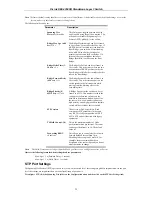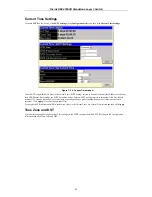
D-Link DES-3350SR Standalone Layer 3 Switch
35
VLANs
A VLAN is a collection of end nodes grouped by logic rather than physical location. End nodes that frequently communicate with
each other are assigned to the same VLAN, regardless of where they are located physically on the network. Logically, a VLAN can
be equated to a broadcast domain, because broadcast packets are forwarded only to members of the VLAN on which the broadcast
was initiated.
VLANs on the DES-3350SR
The DES-3350SR supports IEEE 802.1Q VLANs. The port untagging function can be used to remove the 802.1Q tag from packet
headers to maintain compatibility with devices that are tag-unaware (that is, network devices that do not support IEEE 802.1Q
VLANs or tagging). The switch’s default is to assign all ports to a single 802.1Q VLAN named “default.”
IEEE 802.1Q VLANs
Some relevant terms:
•
Tagging
– The act of putting 802.1Q VLAN information into the header of a packet.
•
Untagging
– The act of stripping 802.1Q VLAN information out of the packet header.
•
Ingress port
– A port on a switch where packets are flowing into the switch and VLAN decisions must be made.
•
Egress port
– A port on a switch where packets are flowing out of the switch, either to another switch or to an end station,
and tagging decisions must be made.
IEEE 802.1Q (tagged) VLANs are implemented on the DES-3350SR Layer 2 switch. 802.1Q VLANs require tagging, which
enables the VLANs to span an entire network (assuming all switches on the network are IEEE 802.1Q-compliant).
Any port can be configured as either
tagging
or
untagging
. The
untagging
feature of IEEE 802.1Q VLANs allow VLANs to work
with legacy switches that don’t recognize VLAN tags in packet headers. The
tagging
feature allows VLANs to span multiple
802.1Q-compliant switches through a single physical connection and allows Spanning Tree to be enabled on all ports and work
normally.
802.1Q VLAN Packet Forwarding
Packet forwarding decisions are made based upon the following three types of rules:
•
Ingress rules – rules relevant to the classification of received frames belonging to a VLAN.
•
Forwarding rules between ports – decides filter or forward the packet
•
Egress rules – determines if the packet must be sent tagged or untagged.
Figure 7 - 16. IEEE 802.1Q Packet Forwarding
802.1Q VLAN Tags
The figure below shows the 802.1Q VLAN tag. There are four additional octets inserted after the source MAC address. Their
presence is indicated by a value of 0x8100 in the EtherType field. When a packet’s EtherType field is equal to 0x8100, the packet
carries the IEEE 802.1Q/802.1p tag. The tag is contained in the following two octets and consists of 3 bits or user priority, 1 bit of
Canonical Format Identifier (CFI – used for encapsulating Token Ring packets so they can be carried across Ethernet backbones)
and 12 bits of VLAN ID (VID). The 3 bits of user priority are used by 802.1p. The VID is the VLAN identifier and is used by the
802.1Q standard. Because the VID is 12 bits long, 4094 unique VLANs can be identified.
The tag is inserted into the packet header making the entire packet longer by four octets. All of the information contained in the
packet originally is retained.
Summary of Contents for DES-3350SR
Page 1: ...D Link DES 3350SR Standalone Layer 3 Switch User s Guide...
Page 80: ...D Link DES 3350SR Standalone Layer 3 Switch 70 Figure 7 57 The Client...
Page 138: ...D Link DES 3350SR Standalone Layer 3 Switch 128 Click Apply to implement changes made...
Page 160: ...D Link DES 3350SR Standalone Layer 3 Switch 150 Figure 10 33 PIM Neighbor Table...
Page 188: ......
















































